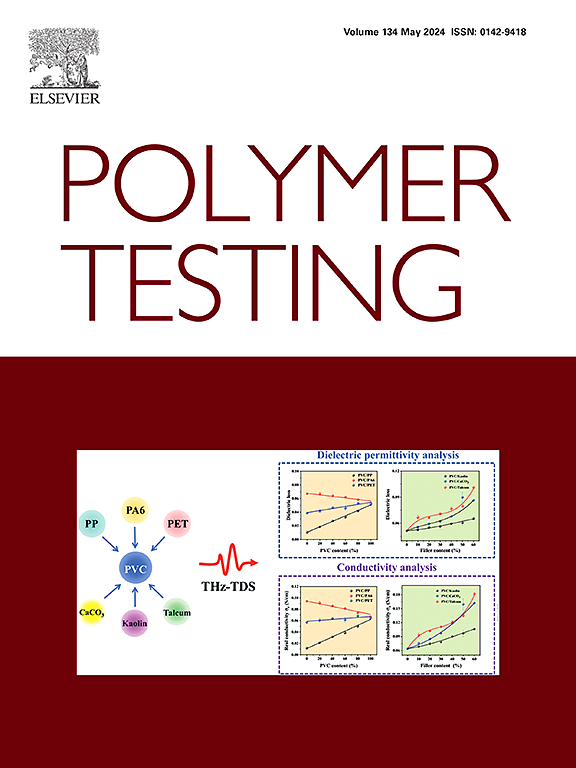Fiber Bragg grating in-situ detection method for curing characteristics of GIS epoxy/Al2O3 composite insulation materials
IF 5
2区 材料科学
Q1 MATERIALS SCIENCE, CHARACTERIZATION & TESTING
引用次数: 0
Abstract
Excessive residual strain generated by curing shrinkage of epoxy/Al2O3 composite insulation materials can reduce the mechanical properties of gas-insulated metal-enclosed switchgear (GIS) insulators. The process and formula optimization of insulators lack effective detection methods. A thermocouple-compensated fiber Bragg grating in-situ detection method for seven high-temperature curing characteristics is proposed. The curing shrinkage characteristics and residual strain generation mechanism of this material cured at 114 °C are studied. The cured residual strain is calculated by the total central wavelength shift of the grating and the thermocouple temperature change inside the sample at the end of the curing process. The curing degree, curing initiation time, and curing completion time are calculated by the temperature inside the sample and the surface temperature of the mold based on the law of thermal equilibrium. Gel time, gel temperature, and glass transition temperature are detected by linear fitting and differential analysis of the strain variation with temperature inside the sample based on the thermal expansion coefficient. Differential scanning calorimetry and SB(m, n) autocatalytic reaction model are used to calculate the curing kinetic equation and to comparatively verify the glass transition temperature and curing degree. The differences between the two test results of the glass transition temperature, curing initiation time, and curing completion time are 0.39 %, 11.2 %, and 17.6 %, respectively. The proposed method can be used for detecting and evaluating the processes and formulations of GIS insulators in the same batch of production samples and optimizing the processes and formulations.
GIS环氧树脂/Al2O3复合绝缘材料固化特性的光纤光栅原位检测方法
环氧树脂/Al2O3复合绝缘材料固化收缩产生的过量残余应变会降低气体绝缘金属封闭开关设备(GIS)绝缘子的力学性能。绝缘子的工艺和配方优化缺乏有效的检测方法。提出了一种热电偶补偿光纤光栅7种高温固化特性的原位检测方法。研究了该材料在114℃固化后的固化收缩特性和残余应变产生机理。在固化过程结束时,通过光栅的总中心波长位移和样品内部热电偶温度变化来计算固化残余应变。根据热平衡定律,由试样内部温度和模具表面温度计算出固化程度、固化起始时间和固化完成时间。根据热膨胀系数对试样内部应变随温度的变化进行线性拟合和微分分析,检测凝胶时间、凝胶温度和玻璃化转变温度。采用差示扫描量热法和SB(m, n)自催化反应模型计算了固化动力学方程,对比验证了玻璃化转变温度和固化程度。玻璃化转变温度、固化起始时间和固化完成时间两项试验结果的差异分别为0.39%、11.2%和17.6%。该方法可用于对同批次生产样品中GIS绝缘子的工艺和配方进行检测和评价,并对工艺和配方进行优化。
本文章由计算机程序翻译,如有差异,请以英文原文为准。
求助全文
约1分钟内获得全文
求助全文
来源期刊

Polymer Testing
工程技术-材料科学:表征与测试
CiteScore
10.70
自引率
5.90%
发文量
328
审稿时长
44 days
期刊介绍:
Polymer Testing focuses on the testing, analysis and characterization of polymer materials, including both synthetic and natural or biobased polymers. Novel testing methods and the testing of novel polymeric materials in bulk, solution and dispersion is covered. In addition, we welcome the submission of the testing of polymeric materials for a wide range of applications and industrial products as well as nanoscale characterization.
The scope includes but is not limited to the following main topics:
Novel testing methods and Chemical analysis
• mechanical, thermal, electrical, chemical, imaging, spectroscopy, scattering and rheology
Physical properties and behaviour of novel polymer systems
• nanoscale properties, morphology, transport properties
Degradation and recycling of polymeric materials when combined with novel testing or characterization methods
• degradation, biodegradation, ageing and fire retardancy
Modelling and Simulation work will be only considered when it is linked to new or previously published experimental results.
 求助内容:
求助内容: 应助结果提醒方式:
应助结果提醒方式:


